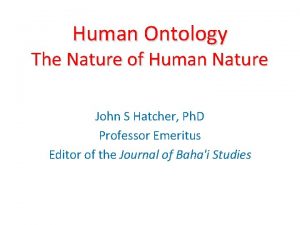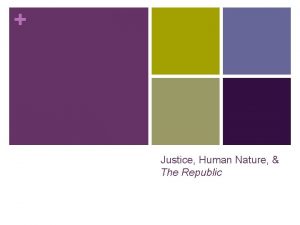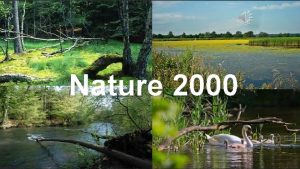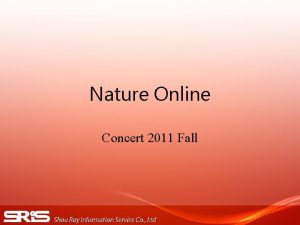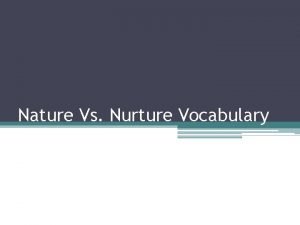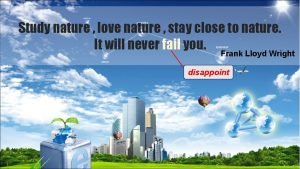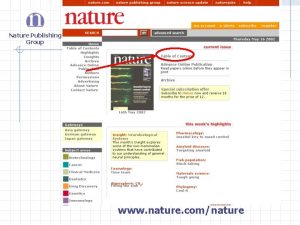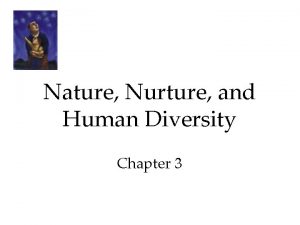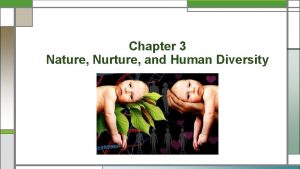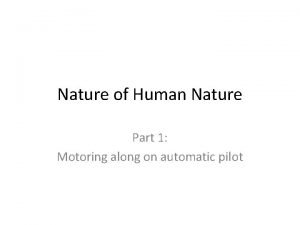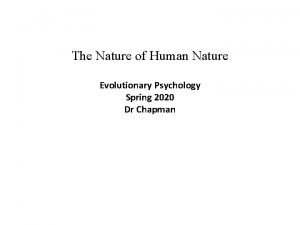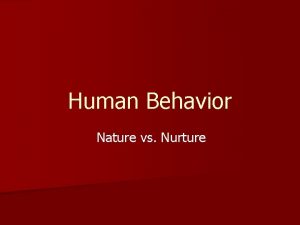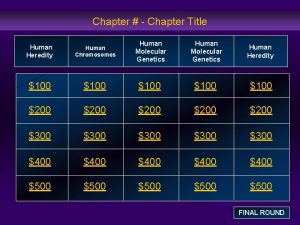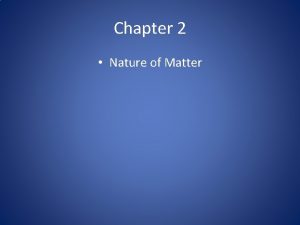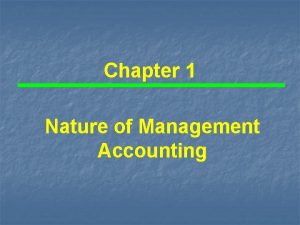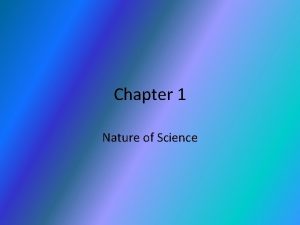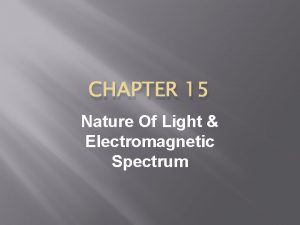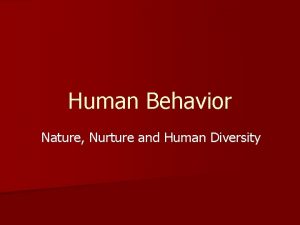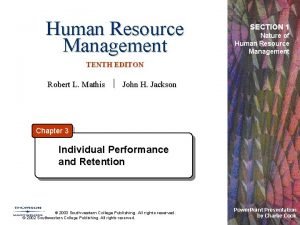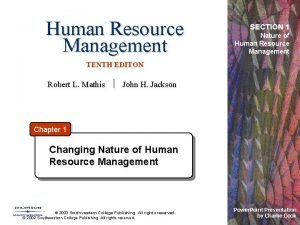The Human Nature of Nature Chapter 8 Human



























- Slides: 27

The Human Nature of Nature Chapter 8

Human Nature of Nature • Nature is one of most powerful human concepts. • People often put selves at risk in defense of nature. • Nature also one of most dangerous concepts. © Pine Forge Press, an Imprint of SAGE Publications, Inc. , 2009.

Contradictions of Nature • Contradiction of Moral Holism and Moral Separatism • Moral Holism – people are part of nature, therefore no need to ‘follow’ it. • Moral Separatism – people are separate from nature, nature is different from us, moved by different principles, it has no meaning for us. • Moral value requires contrast, a way to make moral distinctions, but also a point of connection. © Pine Forge Press, an Imprint of SAGE Publications, Inc. , 2009.

Power and Interest • Central to the natural conscience. • Depends upon person’s subjective belief in a moral realm that lies beyond reach of social power and possibility of manipulation to suit interests of some more than others. • Requires separation from society to be free from social influence, requires holist unity if it is to be relevant to social issues. • But no holist unity in conception of nature. © Pine Forge Press, an Imprint of SAGE Publications, Inc. , 2009.

Ancient Problems, Ancient Solutions • Aristotle – Distinguish between natural and non-natural – Anything that humans make is not due to nature, although the materials humans use may well be. For example: wooden bed. © Pine Forge Press, an Imprint of SAGE Publications, Inc. , 2009.

Aristotle: Connections and Contrast • Humans are part of nature because they have source of change inside themselves. – But… when humans use source of change to alter something outside themselves, they are not acting in accordance to nature. • Points of moral connection and contrast. • Nature was interest-free: establish a natural conscience. © Pine Forge Press, an Imprint of SAGE Publications, Inc. , 2009.

Taoists and Moral Connection • Tao: something larger and prior to humans, lies beyond taint of human interests and desires. – Serving as basis for a natural conscience. • Point of moral connection: – Suggesting Tao is underlying first principle of everything, including humans. © Pine Forge Press, an Imprint of SAGE Publications, Inc. , 2009.

Contradictions of Contemporary Environmentalism • Word “natural” sets clear moral contrast between good and bad. • Dubious moral claim: – Things that come about through own internal source of change are natural and not the product of human desires and interests. • But aren’t humans part of nature? © Pine Forge Press, an Imprint of SAGE Publications, Inc. , 2009.

Wilderness as ‘natural’ • Often seen as fullest expression of the true ends of nature and environmentalism. • Wilderness = land set aside from deliberate human interference. • Contradiction: isn’t very setting aside of land a deliberate human action, thereby making wilderness the product of human intention rather than the result of its absence? © Pine Forge Press, an Imprint of SAGE Publications, Inc. , 2009.

Moral Dilemma • Moral problem: – Environmentalism needs to establish the relevance of nature to humans by arguing for our unity with it. – At same time, must contrast humans and nature in order to set aside a realm that is free from the pollution of human interests. © Pine Forge Press, an Imprint of SAGE Publications, Inc. , 2009.

Social Construction of Nature • Nature is something we make as much as it makes us. • How we see nature depends upon our perspective on social life. – Perspective changes across time and place, history and culture. – Nature changes with it. © Pine Forge Press, an Imprint of SAGE Publications, Inc. , 2009.

Images of Nature • Depend on social selection and social reflection. • Often select particular features of nature to focus upon, ignoring those that do not suit our interests and worldview shaped by those interests. • Categories we use to comprehend nature closely reflect categories we use to comprehend society. • “Nature” is an inescapably social – and political phenomenon. © Pine Forge Press, an Imprint of SAGE Publications, Inc. , 2009.

Naturalizing Capitalism • Based on Darwin’s theory of natural selection. • Discuss economic “forces” of capitalism innovation and competition - as if they were pseudo-natural processes – implying that any other arrangement would be somehow unnatural. • Marketplace described as a “jungle” in which you have to “struggle to survive. ” • Naturalization can subtly give us the sense that the current form of our economy is inevitable and that it is foolishly idealistic to think otherwise. © Pine Forge Press, an Imprint of SAGE Publications, Inc. , 2009.

Nature and Scientific Racism • History of naturalizing arguments by scientists attempting to prove inherent differences in capabilities of human “races. ” – Morton’s Craniometry: 19 th century scientific fad that compared cranial capacities of different races. – Huntington’s Environmental Determinism: relationship between climate and the degree of civilization of a people. • Power - and danger - of nature as a social idea: – Often attempt to use it to legitimate social inequality © Pine Forge Press, an Imprint of SAGE Publications, Inc. , 2009.

Environment as Social Construction • Argument: Same processes of social selection and social reflection in our understandings of nature can be seen in environmentalism itself. • This view threatened natural conscience of environmentalists and many environmental sociologists. © Pine Forge Press, an Imprint of SAGE Publications, Inc. , 2009.

Realist-Constructionist Debate • Main counter charge against the constructionists was that they were denying the reality of environmental problems. – Contributing to immobilization of environmental politics. • Debate was healthy: – now understand realism and constructionism, with roots in age-old discussion of materialist versus idealist approaches, as fundamental conceptual tension in environmental sociology. © Pine Forge Press, an Imprint of SAGE Publications, Inc. , 2009.

Critical Realism • A realism that embraces recognition that we can only understand reality by way of our ideas. © Pine Forge Press, an Imprint of SAGE Publications, Inc. , 2009.

Constructionist Critique of Environmentalism • “Ozone Hole” vs. “Ozone Depletion” – Example of social selection in environmental understanding, leading to a particular representation for a particular narrative purpose. © Pine Forge Press, an Imprint of SAGE Publications, Inc. , 2009.

Constructing Wilderness • Highest exemplar of natural. – Also based on often forcible absence of, and regulation of, one widespread aspect of the natural world: people. • Such an approach to environmental protection is based on a culturally specific understanding of what the environment is and could be – a North American understanding. © Pine Forge Press, an Imprint of SAGE Publications, Inc. , 2009.

Constructing Wilderness Globally • In South and Southeast Asia -people and wildlife in populated areas may coexist harmoniously. – View people as living in harmony with nature, part of nature and beneficial to nature. • Wilderness is, in the end, a state of mind more than a state of nature. • Argument: We should not universalistically, and imperialistically, promote such a culturally specific notion as a no-people vision of wilderness in places where it may lead to social injustice and may even undermine biodiversity. © Pine Forge Press, an Imprint of SAGE Publications, Inc. , 2009.

Tourism and Social Construction of Landscape • Rise in tourism related to rise in environmentalism. – Tourists often come to see ‘nature’ • Culture of Leisure – Tourists tend to objectify landscape, using its visual qualities as cultural opportunity for leisure. • We see landscape differently, and for different purposes, depending upon who we are. – Also depends on social associations we experience in it. • Ghosts of place – Build a feeling of attachment to that place through our attachment to the ghosts we sense there. © Pine Forge Press, an Imprint of SAGE Publications, Inc. , 2009.

Promoting “ghosts of place” to Tourists • Vermont: – Ghost of rural life attached to state’s mountains, ski slopes, ice cream, cheese, maple syrup, and pancake mix - even to its mail-order Christmas wreaths. © Pine Forge Press, an Imprint of SAGE Publications, Inc. , 2009.

Political Landscapes • The experience of a landscape - both what we see and “see” - is political. • Tourists/tourism businesses they support are usually at advantage in conflicts over landscape. – Tourists tend to be wealthier than local people, and tourism businesses are often backed by corporate interests and by national and regional governments eager to generate foreign exchange and tax revenues. – In situation of inequality, it is particularly challenging to manage a commons democratically. © Pine Forge Press, an Imprint of SAGE Publications, Inc. , 2009.

Social Construction of Environmental Exclusion • Use of environmental arguments for social exclusion. • Restrictive zoning policies to ‘protect nature’ help perpetuate inequalities. • Population growth arguments used to deter or stop immigration. © Pine Forge Press, an Imprint of SAGE Publications, Inc. , 2009.

Dialogue of Nature and Ideology • Nature is contradictory and contested conceptual realm. – Social and political phenomenon as much as a physical one. • Social constructionism has many dangers: – It can become a kind of universalism itself. – Incapacitating for any effort to improve social and environmental conditions, just another social construction. – Remain in purely ideal realm, unwilling to engage the material side of the ecological dialogue. © Pine Forge Press, an Imprint of SAGE Publications, Inc. , 2009.

Actors and Actants • Latour: should regard elements of what we often call “nature” and the “environment” as actors in a common network with human actors or actants. • Actor Network Theory – Actants mutually constitute one another through actor networks. – What makes us human is our understanding of how the rest of the world interacts with us, how it responds to us in the ways we conceptualize as the ways humans are responded to. © Pine Forge Press, an Imprint of SAGE Publications, Inc. , 2009.

Resonance • Similarities in the categories we use to understand human networks and human/nonhuman networks are striking. • Theory of Natural Selection • Intellectual resonance. – We tend to favor patterns of understanding that work well across - that resonate with - the range of our experience. • We construct nature and nature constructs us. © Pine Forge Press, an Imprint of SAGE Publications, Inc. , 2009.
 Hình ảnh bộ gõ cơ thể búng tay
Hình ảnh bộ gõ cơ thể búng tay Lp html
Lp html Bổ thể
Bổ thể Tỉ lệ cơ thể trẻ em
Tỉ lệ cơ thể trẻ em Voi kéo gỗ như thế nào
Voi kéo gỗ như thế nào Tư thế worm breton
Tư thế worm breton Chúa yêu trần thế alleluia
Chúa yêu trần thế alleluia Các môn thể thao bắt đầu bằng tiếng bóng
Các môn thể thao bắt đầu bằng tiếng bóng Thế nào là hệ số cao nhất
Thế nào là hệ số cao nhất Các châu lục và đại dương trên thế giới
Các châu lục và đại dương trên thế giới Công thức tính thế năng
Công thức tính thế năng Trời xanh đây là của chúng ta thể thơ
Trời xanh đây là của chúng ta thể thơ Mật thư anh em như thể tay chân
Mật thư anh em như thể tay chân Phép trừ bù
Phép trừ bù độ dài liên kết
độ dài liên kết Các châu lục và đại dương trên thế giới
Các châu lục và đại dương trên thế giới Thơ thất ngôn tứ tuyệt đường luật
Thơ thất ngôn tứ tuyệt đường luật Quá trình desamine hóa có thể tạo ra
Quá trình desamine hóa có thể tạo ra Một số thể thơ truyền thống
Một số thể thơ truyền thống Cái miệng nó xinh thế chỉ nói điều hay thôi
Cái miệng nó xinh thế chỉ nói điều hay thôi Vẽ hình chiếu vuông góc của vật thể sau
Vẽ hình chiếu vuông góc của vật thể sau Thế nào là sự mỏi cơ
Thế nào là sự mỏi cơ đặc điểm cơ thể của người tối cổ
đặc điểm cơ thể của người tối cổ Ví dụ giọng cùng tên
Ví dụ giọng cùng tên Vẽ hình chiếu đứng bằng cạnh của vật thể
Vẽ hình chiếu đứng bằng cạnh của vật thể Vẽ hình chiếu vuông góc của vật thể sau
Vẽ hình chiếu vuông góc của vật thể sau Thẻ vin
Thẻ vin đại từ thay thế
đại từ thay thế





























